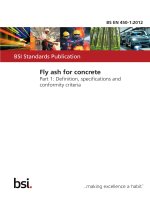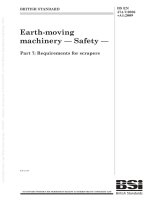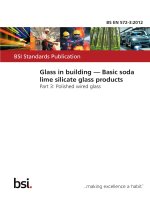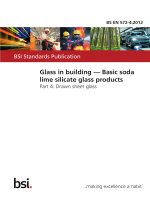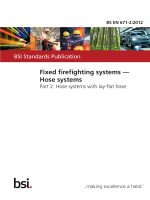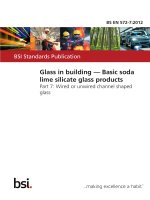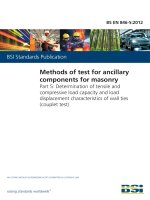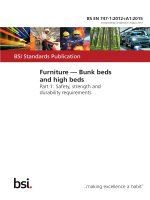Bsi bs en 62149 7 2012
Bạn đang xem bản rút gọn của tài liệu. Xem và tải ngay bản đầy đủ của tài liệu tại đây (1.33 MB, 38 trang )
BS EN 62149-7:2012
BSI Standards Publication
Fibre optic active components
and devices — Performance
standards
Part 7: 1 310 nm discrete vertical cavity
surface emitting laser devices
BRITISH STANDARD
BS EN 62149-7:2012
National foreword
This British Standard is the UK implementation of EN 62149-7:2012. It is
identical to IEC 62149-7:2012.
The UK participation in its preparation was entrusted by Technical Committee
GEL/86, Fibre optics, to Subcommittee GEL/86/3, Fibre optic systems and
active devices.
A list of organizations represented on this committee can be obtained on
request to its secretary.
This publication does not purport to include all the necessary provisions of a
contract. Users are responsible for its correct application.
© The British Standards Institution 2012
Published by BSI Standards Limited 2012
ISBN 978 0 580 74339 9
ICS 33.180.20
Compliance with a British Standard cannot confer immunity from
legal obligations.
This British Standard was published under the authority of the Standards
Policy and Strategy Committee on 30 June 2012.
Amendments issued since publication
Amd. No.
Date
Text affected
BS EN 62149-7:2012
EUROPEAN STANDARD
EN 62149-7
NORME EUROPÉENNE
May 2012
EUROPÄISCHE NORM
ICS 33.180.20
English version
Fibre optic active components and devices Performance standards Part 7: 1 310 nm discrete vertical cavity surface emitting laser devices
(IEC 62149-7:2012)
Composants et dispositifs actifs
à fibres optiques Norme de performance Partie 7: Dispositifs discrets
à laser 1 310 nm émettant en surface
(CEI 62149-7:2012)
Aktive Lichtwellenleiterbauelemente
und -geräte Betriebsverhaltensnormen Teil 7: 1 310 nm oberflächenemittierender
Laser-Bauteile mit vertikalem Resonator
(IEC 62149-7:2012)
This European Standard was approved by CENELEC on 2012-05-03. CENELEC members are bound to comply
with the CEN/CENELEC Internal Regulations which stipulate the conditions for giving this European Standard
the status of a national standard without any alteration.
Up-to-date lists and bibliographical references concerning such national standards may be obtained on
application to the CEN-CENELEC Management Centre or to any CENELEC member.
This European Standard exists in three official versions (English, French, German). A version in any other
language made by translation under the responsibility of a CENELEC member into its own language and notified
to the CEN-CENELEC Management Centre has the same status as the official versions.
CENELEC members are the national electrotechnical committees of Austria, Belgium, Bulgaria, Croatia, Cyprus,
the Czech Republic, Denmark, Estonia, Finland, France, Germany, Greece, Hungary, Iceland, Ireland, Italy,
Latvia, Lithuania, Luxembourg, Malta, the Netherlands, Norway, Poland, Portugal, Romania, Slovakia, Slovenia,
Spain, Sweden, Switzerland, Turkey and the United Kingdom.
CENELEC
European Committee for Electrotechnical Standardization
Comité Européen de Normalisation Electrotechnique
Europäisches Komitee für Elektrotechnische Normung
Management Centre: Avenue Marnix 17, B - 1000 Brussels
© 2012 CENELEC -
All rights of exploitation in any form and by any means reserved worldwide for CENELEC members.
Ref. No. EN 62149-7:2012 E
BS EN 62149-7:2012
EN 62149-7:2012
-2-
Foreword
The text of document 86C/1021/CDV, future edition 1 of IEC 62149-7, prepared by IEC/TC 86 "Fibre
optics" was submitted to the IEC-CENELEC parallel vote and approved by CENELEC as
EN 62149-7:2012.
The following dates are fixed:
•
latest date by which the document has
to be implemented at national level by
publication of an identical national
standard or by endorsement
(dop)
2013-02-03
•
latest date by which the national
standards conflicting with the
document have to be withdrawn
(dow)
2015-05-03
Attention is drawn to the possibility that some of the elements of this document may be the subject of
patent rights. CENELEC [and/or CEN] shall not be held responsible for identifying any or all such
patent rights.
Endorsement notice
The text of the International Standard IEC 62149-7:2012 was approved by CENELEC as a European
Standard without any modification.
In the official version, for Bibliography, the following notes have to be added for the standards indicated:
IEC 60191 series
NOTE
Harmonized as EN 60191 series (not modified).
IEC 60747-5-1
NOTE
Harmonized as EN 60747-5-1.
IEC 60793-2
NOTE
Harmonized as EN 60793-2.
IEC 60874 series
NOTE
Harmonized as EN 60874 series (not modified).
IEC 61280-1-3
NOTE
Harmonized as EN 61280-1-3.
IEC 62007-1
NOTE
Harmonized as EN 62007-1.
IEC 62007-2
NOTE
Harmonized as EN 62007-2.
IEC 62148-1
NOTE
Harmonized as EN 62148-1.
IEC 62149-1
NOTE
Harmonized as EN 62149-1.
IEC 62149-4
NOTE
Harmonized as EN 62149-4.
BS EN 62149-7:2012
EN 62149-7:2012
-3-
Annex ZA
(normative)
Normative references to international publications
with their corresponding European publications
The following documents, in whole or in part, are normatively referenced in this document and are
indispensable for its application. For dated references, only the edition cited applies. For undated
references, the latest edition of the referenced document (including any amendments) applies.
NOTE When an international publication has been modified by common modifications, indicated by (mod), the relevant EN/HD
applies.
Publication
Year
IEC 60749
Title
EN/HD
Year
Series Semiconductor devices - Mechanical and
climatic test methods
EN 60749
Series
IEC 60825-1
-
Safety of laser products - Part 1: Equipment
classification and requirements
EN 60825-1
-
IEC 60950-1
-
Information technology equipment - Safety Part 1: General requirements
EN 60950-1
-
IEC 61300-2-4
-
Fibre optic interconnecting devices and
passive components - Basic test and
measurement procedures - Part 2-4: Tests Fibre/cable retention
EN 61300-2-4
-
IEC 61300-2-19
-
Fibre optic interconnecting devices and
EN 61300-2-19
passive components - Basic test and
measurement procedures - Part 2-19: Tests Damp heat (steady state)
-
IEC 61300-2-48
-
EN 61300-2-48
Fibre optic interconnecting devices and
passive components - Basic test and
measurement procedures - Part 2-48: Tests Temperature-humidity cycling
-
IEC 62148-15
-
Fibre optic active components and devices - EN 62148-15
Package and interface standards - Part 15:
Discrete vertical cavity surface emitting laser
packages
-
IEC Guide 107
1998
Electromagnetic compatibility - Guide to the
drafting of electromagnetic compatibility
publications
-
-
–2–
BS EN 62149-7:2012
62149-7 © IEC:2012
CONTENTS
INTRODUCTION ..................................................................................................................... 6
1
Scope ............................................................................................................................... 7
2
Normative references ....................................................................................................... 7
3
Terms, definitions, symbols and abbreviated terms ........................................................... 8
4
3.1 Terms and definitions .............................................................................................. 8
3.2 Symbols and abbreviated terms............................................................................... 9
Product parameters .......................................................................................................... 9
5
4.1 Absolute limiting ratings .......................................................................................... 9
4.2 Operating environment ............................................................................................ 9
4.3 Functional specification ......................................................................................... 10
4.4 Diagrams ............................................................................................................... 10
Testing ........................................................................................................................... 10
6
5.1 General ................................................................................................................. 10
5.2 Characterization testing ......................................................................................... 10
5.3 Performance testing .............................................................................................. 10
Environmental specifications .......................................................................................... 10
6.1 General safety ....................................................................................................... 10
6.2 Laser safety .......................................................................................................... 10
6.3 Electromagnetic compatibility (EMC) requirements ................................................ 11
Annex A (normative) Specifications for multimode 1 310-nm VCSEL device without a
monitor photodiode (Case a) ................................................................................................. 12
Annex B (normative) Specifications for multimode 1 310-nm VCSEL device with a
monitor photodiode (Case b) ................................................................................................. 16
Annex C (normative) Specifications for single-mode 1 310-nm VCSEL device without a
monitor photodiode (Case c) ................................................................................................. 21
Annex D (normative) Specifications for single-mode 1 310-nm VCSEL device with a
monitor photodiode (Case d) ................................................................................................. 27
Bibliography .......................................................................................................................... 33
Table 1 – Subcategorized specifications of the 1 310-nm discrete VCSEL .............................. 7
Table 2 – Operating environment .......................................................................................... 10
Table A.1 – Absolute limiting ratings ..................................................................................... 12
Table A.2 – Operating conditions for functional specification................................................. 12
Table A.3 – Functional specification ...................................................................................... 13
Table A.4 – Performance test plan ........................................................................................ 14
Table A.5 – Recommended performance test failure criteria ................................................. 15
Table B.1 – Absolute limiting ratings ..................................................................................... 16
Table B.2 – Operating conditions for functional specification................................................. 16
Table B.3 – Functional specification ...................................................................................... 17
Table B.4 – Performance test plan ........................................................................................ 19
Table B.5 – Recommended performance test failure criteria ................................................. 20
BS EN 62149-7:2012
62149-7 © IEC:2012
–3–
Table C.1 – Absolute limiting ratings ..................................................................................... 21
Table C.2 – Operating conditions for functional specification ................................................ 21
Table C.3 – Functional specification ..................................................................................... 22
Table C.4 – Performance test plan ........................................................................................ 25
Table C.5 – Recommended performance test failure criteria ................................................. 26
Table D.1 – Absolute limiting ratings ..................................................................................... 27
Table D.2 – Operating conditions for functional specification ................................................ 27
Table D.3 – Functional specification ..................................................................................... 28
Table D.4 – Performance test plan ........................................................................................ 31
Table D.5 – Recommended performance test failure criteria ................................................. 32
–6–
BS EN 62149-7:2012
62149-7 © IEC:2012
INTRODUCTION
Fibre optic laser devices are used to convert electrical signals into optical signals. This part of
IEC 62149 covers the performance specification for 1 310 nm discrete vertical cavity surface
emitting laser devices in fibre optic telecommunication and optical data transmission
applications.
BS EN 62149-7:2012
62149-7 © IEC:2012
–7–
FIBRE OPTIC ACTIVE COMPONENTS AND DEVICES –
PERFORMANCE STANDARDS –
Part 7: 1 310-nm discrete vertical cavity
surface emitting laser devices
1
Scope
This part of IEC 62149 covers the performance specification for 1 310-nm discrete vertical
cavity surface emitting laser (VCSEL) devices of transverse single-mode and multimode types
used for the fibre optic telecommunication and optical data transmission application in a form
of the VCSEL chips mounted on a substrate with wire bonding to their chips’ anode and
cathode terminals without any fibre pigtails. The performance standard contains a definition of
the product performance requirements together with a series of sets of tests and
measurements with clearly defined conditions, severities, and pass/fail criteria. The tests are
intended to be run on a “one-off” basis to prove any product’s ability to satisfy the
performance standard’s requirements.
A product that has been shown to meet all the requirements of a performance standard can
be declared as complying with the performance standard, but should then be controlled by a
quality assurance/quality conformance program.
Depending on the signalling speed and application areas, subcategorized specifications of the
1 310-nm discrete VCSEL are defined as shown in Table 1.
Table 1 – Subcategorized specifications of the 1 310-nm discrete VCSEL
1,0625
GBd
Fibre
Channel
Ethernet
1,25
GBd
FC1GB
2,125
GBd
3,125
GBd
FC2GB
4,25
GBd
8,5
GBd
FC4GB
FC8GB
10 GBd a
16 GBd
25,78125
GBd
FC16GB
b
E1A1a
E3A1a
E10BLR
E1A1b
E3A1b
E10BLW
E1B
E10BLX4
E40BLR4
E25B c
NOTE Bd is baud rate; A1a is 50 µm core multimode fibre; A1b is 62, 5 µm core multimode fibre; B is singlemode fibre; LR is 10 G LAN; LW is 10 G WAN; LR4 is 40 G WDM. (Refer to IEC 60793-2, IEEE 802.3-2002,
INCITS 450-2009, INCITS/Project 2118-D/Rev1.00-2008.09.25, IEEE 802.3-2005, and IEEE P802.3ba-2009.)
a
Nominal signal rate of 10 G Ethernet is 10,312 5 GBd for E10BLR and E40BLR4 and 9,953 28 GBd for
E10BLW.
b, c
VCSEL specifications for signalling rates of 16 GBd, 25,781 25 GBd and above are left for future works.
Each subcategorized specification is also defined by separate details depending on the
device types, such as specifications for a VCSEL device without a monitor photodiode (Case
a) and for a VCSEL device with a monitor photodiode (Case b).
2
Normative references
The following documents, in whole or in part, are normatively referenced in this document and
are indispensable for its application. For dated references, only the edition cited applies. For
undated references, the latest edition of the referenced document (including any
amendments) applies.
–8–
BS EN 62149-7:2012
62149-7 © IEC:2012
IEC 60749 (all parts), Semiconductor devise – Mechanical and climate test methods
IEC 60825-1: Safety of laser products – Part 1: Equipment classification and requirements
IEC 60950-1, Information technology equipment – Safety – Part 1: General requirements
IEC 61300-2-4, Fibre optic interconnecting devices and passive components – Basic test and
measurement procedures – Part 2-4: Tests – Fibre/cable retention
IEC 61300-2-19, Fibre optic interconnecting devices and passive components – Basic test
and measurement procedures – Part 2-19: Tests – Damp heat (steady state)
IEC 61300-2-48, Fibre optic interconnecting devices and passive components – Basic test
and measurement procedures – Part 2-48: Tests – Temperature-humidity cycling
IEC 62148-15, Fibre optic active components and devices – Package and interface
standards – Part 15: Discrete vertical cavity surface emitting laser packages
IEC Guide 107: 1998, Electromagnetic compatibility – Guide to the drafting of electromagnetic
compatibility publications
3
Terms, definitions, symbols and abbreviated terms
NOTE Terminology concerning the physical concepts, the types of devices, the general terms, and that related to
ratings and characteristics of semiconductor devices can be found in IEC 60747-5-1. In addition, the definition for
the essential ratings and characteristics of the semiconductor optoelectronic devices for fibre optic system
applications can be found in IEC 62007-1.
3.1 Terms and definitions
For the purposes of this document, the following terms and definitions apply.
NOTE The following terms are defined for the specific characteristics of vertical cavity surface emitting laser
devices.
3.1.1
modulation speed
digital modulation speed with an optimum modulation amplitude between the operating current
and threshold current level
3.1.2
multimode
cross-section transverse mode of the laser beam profile with mode number greater than one
Note 1 to entry: This means that the intensity profile has more than one spot, compared to the single-mode which
corresponds to the cross-section transverse mode of the laser beam profile with mode number of one having the
intensity profile of one circular spot.
3.1.3
laser wavelength
peak central laser wavelength of the vertical cavity surface emitting laser device when it is
operated at the normal operating conditions which is specified in the sectional specification of
the VCSEL
3.1.4
submount
substrate upon which a laser is mounted for assembly into the further packaging
BS EN 62149-7:2012
62149-7 © IEC:2012
–9–
3.1.5
transverse mode
cross-sectional profile of the optical beam intensity at the laser output of the VCSEL
Note 1 to entry: Depending on the mode status between multimode and single-mode, the package type of the
VCSEL devices is also defined.
3.1.6
VCSEL device with a monitor photodiode
VCSEL packaged device with a monitor photodiode
3.1.7
VCSEL device without a monitor photodiode
VCSEL packaged device without a monitor photodiode
3.2 Symbols and abbreviated terms
λp
peak laser wavelength
I th
threshold current
V th
threshold voltage
I op
operating current
Vf
forward voltage at operating current
Rs
series resistance
η
slope efficiency
Po
continuous laser output power (at connector output or pigtailed fibre output for
packaged types)
∆ λ T /∆T
wavelength change over temperature
θ
beam divergence at 1/e 2 intensity
t r /t f
rise and fall time from 20 % to 80 % of the peak intensity
C
capacitance of the VCSEL chip
∆λ
spectral width, RMS (at static condition) for multimode VCSELS, -20 dB for
single-mode VCSELs
RIN
relative intensity noise
∆R S /∆T
series resistance temperature coefficient
4
Product parameters
4.1 Absolute limiting ratings
Absolute limiting (maximum and/or minimum) ratings imply that no catastrophic damage will
occur if the product is subject to these ratings for short periods, provided each limiting
parameter is in isolation and all other parameters have values within the normal performance
parameters. It should not be assumed that limiting value of more than one parameter can be
applied at any one time. The absolute maximum ratings of the subcategorized types, E1, E3,
E10, E40 BLR4, FC1GB, FC2GB, FC4GB and FC8GB for signalling speeds are listed in
Annexes A through D, depending on the transverse mode of the VCSELs between multimode
and single-mode and on the monitor photodiode packaged together or unpackaged.
4.2 Operating environment
The operating environment of all the subcategorized types of the 1 310 nm VCSEL is
specified in Table 2.
BS EN 62149-7:2012
62149-7 © IEC:2012
– 10 –
Table 2 – Operating environment
Parameter
Operating temperature
Symbol
T op
Value
Minimum
Maximum
-40
+85
Unit
°C
4.3 Functional specification
Functional specifications of all the subcategorized types, E1, E3, E10, E40BLR4, FC1GB,
FC2GB, FC4GB, and FC8GB, for signalling speeds and application areas are listed in
Annexes A through D depending on the transverse mode of the VCSELs between multimode
and single-mode and on the monitor photodiode packaged together or unpackaged.
4.4 Diagrams
Diagrams of all the VCSEL device types are included in Annexes A through D.
5
5.1
Testing
General
Initial characterisation and qualification shall be undertaken when a build standard has been
completed and frozen. Qualification maintenance is carried using periodic testing programs.
Test conditions for all tests unless otherwise stated are 25 °C ± 2 °C.
5.2 Characterization testing
Characterisation shall be carried out on at least 20 products taken from at least three different
manufacturing lots. The characteristics and conditions of laser diode are tested at the
operating temperature and the operating current to satisfy the functional specifications
defined in 4.3.
5.3 Performance testing
Performance testing is undertaken when characterization testing is complete. The
performance test plan and recommended performance test failure criteria are specified in
Annexes A through D, depending on the device types.
6
Environmental specifications
6.1 General safety
All products meeting this standard shall conform to IEC 60950-1.
6.2 Laser safety
Fibre optic transmitter and transceiver using the laser diode specified in this document shall
be class 3R laser certified under any condition of operation. This includes single fault
conditions whether coupled into a fibre or out of an open bore. Fibre optic transmitter and
transceiver using the laser diode specified in this document shall be certified to be in
conformance with IEC 60825-1.
Laser safety standards and regulations require that the manufacturer of a laser product
provide information about the product’s laser, safety features, labelling, use, maintenance and
service. This documentation shall explicitly define requirements and usage restrictions on the
host system necessary to meet these safety certifications.
BS EN 62149-7:2012
62149-7 © IEC:2012
– 11 –
6.3 Electromagnetic compatibility (EMC) requirements
Products defined in this specification shall comply with suitable requirements for
electromagnetic compatibility (in terms of both, emission and immunity), depending on
particular usage/environment in which they are intended to be installed or integrated.
Guidance to the drafting of such EMC requirements is provided in IEC Guide 107. Guidance
for electrostatic discharge (ESD) is still under study.
BS EN 62149-7:2012
62149-7 © IEC:2012
– 12 –
Annex A
(normative)
Specifications for multimode 1 310-nm VCSEL device
without a monitor photodiode (Case a)
A.1
Absolute limiting ratings
Absolute limiting (maximum and/or minimum) ratings imply that no catastrophic damage will
occur if the product is subject to these ratings for short periods, provided each limiting
parameter is in isolation and all other parameters have values within the normal performance
parameters. It should not be assumed that a limiting value of more than one parameter can be
applied at any one time. Absolute limiting ratings are shown in Table A.1.
Table A.1 – Absolute limiting ratings
Parameter
Symbol
Storage temperature
T stg
Soldering condition
T sol
Value
Minimum
Maximum
–40
+85
Unit
°C
260 °C,
10 s
Laser diode
A.2
Reverse bias voltage
V RB
5
V
Continuous forward current
I FLD
15
mA
Operating environment
The requirements of 4.2 shall be met.
A.3
Functional specification
Tables A.2 and A.3 contain the operating conditions for functional specifications and the
functional specifications of multimode 1 310-nm VCSEL devices of signalling speeds of
1,25 GBd and 3,125 GBd without a monitor photodiode at the operating conditions.
Table A.2 – Operating conditions for functional specification
Parameter
Symbol
Value
Minimum
Maximum
Unit
Operating forward current
I op
12
mA
Operating forward bias voltage
Vf
2,5
V
Note
BS EN 62149-7:2012
62149-7 © IEC:2012
– 13 –
Table A.3 – Functional specification
Parameter
Symbol
Laser wavelength (for single channel uses)
Value
Unit
Note
1 355
nm
CW, E1A1a,
E1A1b
1 269,0
1 282,4
nm
CW, E3A1a,
E3A1b
λ p_C1
1 293,5
1 306,9
nm
CW, E3A1a,
E3A1b
λ p_C2
1 318,0
1 331,4
nm
CW, E3A1a,
E3A1b
λ p_C3
1 342,5
1 355,9
nm
CW, E3A1a,
E3A1b
Minimum
Maximum
λp
1 270
λ p_C0
Laser diode
Laser wavelength (for four WDM channel
uses)
Spectral width, RMS (for single channel
uses)
∆λ
4
nm
CW
Spectral width, RMS (for four WDM
channel uses)
∆λ
0,62
nm
CW. E3A1a,
E3A1b
Threshold current
I th
0,5
5,0
mA
T 0 =20 °C
Threshold voltage
V th
1,1
2,0
V
Slope efficiency (at I op in a TO package)
η
0,05
0,3
mW/mA
Slope efficiency (at I op in a TOSA or
pigtailed package)
η
0,03
0,2
mW/mA
-7
5
dBm
E1A1a
E1A1b
-7
5
dBm
E3A1a,
E3A1b
-11,5
-3,5
dBm
-0,5
dBm
0,2
nm/°C
260/260
ps
E1A1a,
E1A1b
120/120
ps
E3A1a,
E3A1b
Continuous laser output power (at I op in a
TO package)
PO
Continuous laser output power (at I op in a
TOSA or pigtailed package)
PO
Wavelength change over temperature
Rise and fall time (20 % – 80 %)
∆ λ /∆T
t r /t f
5
Capacitance (VCSEL chip)
Relative intensity noise
Series resistance temperature coefficient
pF
C
E1A1a,
E1A1b
E3A1a,
E3A1b
E1A1a,
E1A1b
V rev = 0 V,
1 MHz
E3A1a,
E3A1b
2
pF
RIN
-120
dB/Hz
a
∆R S /∆T
-4 000
ppm/ o C
b
V rev = 0 V,
1 MHz
a
For 1 GHz bandwidth and optical power specified (typically a negative value)
b
Series resistance of laser diodes decreases as temperature increases and thus its thermal dependent
parameter is typically a negative value.
BS EN 62149-7:2012
62149-7 © IEC:2012
– 14 –
A.4
Diagrams
Refer to IEC 62148-15.
A.5
A.5.1
Testing
Characterization testing
The requirements of 5.1 shall be met.
A.5.2
Performance testing
Performance testing is undertaken when characterization testing is complete. A performance
test plan is shown in Table A.4 and recommended performance test failure criteria in
Table A.5.
Table A.4 – Performance test plan
No.
Test
Reference
1
Endurance test of:
1.1
Package
1.1.1
High temperature
storage
1.1.2
Low temperature
storage
1.1.3
Temperature
cycling
1.1.4
Damp heat
IEC 61300-2-19
1.1.5
Temperaturehumidity cycling
1.1.6
Fibre pull a
1.2
Laser diode
(submount)
nc
Conditions
Temperature: T =Tstg max
Duration: 1 000 h
11
Temperature: T =Tstg min
Duration: > 2 000 h
11
Temperature: T A =Tstg min
T B =Tstg max
Number of cycles = 100
11
T= +40 °C ± 2 °C
RH: 93 % ± 2 %
96 h duration
11
IEC 61300-2-48, method A
–40 °C ± 2 °C to +85 °C ± 2 °C
85 ± 5 % RH at the maximum
temperature
1 hour minimum duration at
extremes
≥ 1 °C/min rate of change
42 cycles
11
IEC 61300-2-4
5 N ± 0,5 N at 0,5 N/s
60 s duration for buffered
fibres
IEC 60749-6
IEC 60749-25
Temperature: at least two test
temperatures:
φ e specified, constant power
1.2.1
11
b
b
Ts1=Ts max
1.2.2
Ts2=< (Ts1-20 °C)
Duration: > 5 000 h
2
Mechanical shock
3
Vibration
IEC 60749-10
1 500 G, 0,5 ms
11
5 times/axis
IEC 60749-12
20 G, 20 Hz – 2 000 Hz,
4 min/cycle, 4cycle/axis
11
BS EN 62149-7:2012
62149-7 © IEC:2012
No.
– 15 –
Test
Reference
4
Rapid change of
temperature
IEC 60749-11
5
ESD
IEC 60749-26
6
Internal moisture
IEC 60749-7
nc
Conditions
ΔT=100 °C, Temperature change
time < 10 s, dwell time > 2 min
temperature reach time < 5 min
15 cycles
Human body model, positive and
negative voltage pulses with a
pulse interval of 300 ms
≤ 5 000 × 10 −6 water vapour
a
Applied to fibre pigtailed packages.
b
These parameters can be determined from negotiation between manufacturer and user.
c
Number of samples
11
3
11
Table A.5 – Recommended performance test failure criteria
Devices
Laser diode
Laser package
a
Parameter
Failure criterion
a
Measurement condition
Operating current
50 % increase
Slope efficiency
10 % change
a
25 °C or life test temperature
Forward voltage
10 % change
a
25 °C or life test temperature
Kinks in L/I curve
Kink-free within 1,2 × P nom
(linearity change ≤10%) a
50 % increase a
Operating current
a
25 °C or life test temperature
T op min, 25 °C, T op max
25 °C or life test temperature
Fibre or connector
output power
10 % change
Kinks in L/I curve
Kink-free within 1,2 × P nom
(linearity change ≤10 %) a
T op min, 25 °C, T op max
Tracking ratio
(I mon / P f ibre )
< LSL ≥ USL
T op min ~ T op max
At rated power level
Change of pre- and post-test values in the DS
Life test temperature
I mon set to initial value
BS EN 62149-7:2012
62149-7 © IEC:2012
– 16 –
Annex B
(normative)
Specifications for multimode 1 310-nm
VCSEL device with a monitor photodiode (Case b)
B.1
Absolute limiting ratings
Absolute limiting (maximum and/or minimum) ratings imply that no catastrophic damage will
occur if the product is subject to these ratings for short periods, provided each limiting
parameter is in isolation and all other parameters have values within the normal performance
parameters. It should not be assumed that limiting value of more than one parameter can be
applied at any one time. Absolute limiting ratings are shown in Table B.1.
Table B.1 – Absolute limiting ratings
Parameter
Symbol
Storage temperature
T stg
Soldering condition
T sol
Value
Minimum
Maximum
−40
+85
Unit
°C
260 °C,
10 sec
Laser diode
Reverse bias voltage
V RB
5
V
Continuous forward current
I FLD
15
mA
Maximum reverse voltage
V mR
5,0
V
Maximum forward current
I mF
2
mA
Monitor photodiode
B.2
Operating environment
The requirements of 4.2 shall be met.
B.3
Functional specification
Tables B.2 and B.3 contain the operating conditions for functional specifications and the
functional specifications of multimode 1 310 nm VCSEL devices of signalling speeds of
1,25 GBd and 3,125 GBd with a monitor photodiode at the operating conditions.
Table B.2 – Operating conditions for functional specification
Parameter
Symbol
Value
Minimum
Maximum
Unit
Operating forward current
I op
12
mA
Operating forward bias voltage
Vf
2,5
V
Note
BS EN 62149-7:2012
62149-7 © IEC:2012
– 17 –
Table B.3 – Functional specification
Parameter
Symbol
Laser wavelength (for single channel uses)
Value
Unit
Note
1 355
nm
CW, E1A1a,
E1A1b
1 269,0
1 282,4
nm
CW, E3A1a,
E3A1b
λ p_C1
1 293,5
1 306,9
nm
CW, E3A1a,
E3A1b
λ p_C2
1 318,0
1 331,4
nm
CW, E3A1a,
E3A1b
λ p_C3
1 342,5
1 355,9
nm
CW, E3A1a,
E3A1b
Minimum
Maximum
λp
1 270
λ p_C0
Laser diode
Laser wavelength (for four WDM channel
uses)
Spectral width, RMS (for single channel
uses)
∆λ
4
nm
CW
Spectral width, RMS (for four WDM
channel uses)
∆λ
0,62
nm
CW. E3A1a,
E3A1b
Threshold current
I th
0,5
5,0
mA
T 0 =20 °C
Threshold voltage
V th
1,1
2,0
V
Slope efficiency (at I op in a TO package)
η
0,05
0,3
mW/mA
Slope efficiency (at I op in a TOSA or
pigtailed package)
η
0,03
0,2
mW/mA
Continuous laser output power (at I op in a
TO package)
PO
-8,5
5
dBm
-8,5
5
dBm
Continuous laser output power (at I op in a
TOSA or pigtailed package)
PO
-11,5
-3,5
dBm
-0,5
dBm
0,2
nm/°C
260/260
ps
E1A1a,
E1A1b
120/120
ps
E3A1a,
E3A1b
Wavelength change over temperature
Rise and fall time
∆ λ /∆T
t r /t f
5
Capacitance (VCSEL chip)
Relative intensity noise
Series resistance temperature coefficient
pF
C
E1A1a,
E1A1b
E3A1a,
E3A1b
E1A1a,
E1A1b
V rev = 0 V,
1 MHz
E3A1a,
E3A1b
2
pF
RIN
-120
dB/Hz
a
∆R S /∆T
-4 000
ppm/°C
b
V rev = 0 V,
1 MHz
c
Monitor photodiode
Monitor current
E1A1a
E1A1b
E3A1a,
E3A1b
Im
0,1
mA
Dark current
I mR0
100
nA
Capacitance d
C tot
100
pF
P op = 0 mW,
V rev = 3 V
V rev = 0 V,
1 MHz
– 18 –
BS EN 62149-7:2012
62149-7 © IEC:2012
a
For 1 GHz bandwidth and optical power specified (typically a negative value).
b
Series resistance of laser diodes decreases as temperature increases and thus its thermal dependent
parameter is typically a negative value.
c
This part applies only to the VCSELs with monitor photodiode at a room temperature condition of 25 °C.
d
This indicates total capacitance between the anode and cathode terminals of the monitor photodiode
subassembly.
B.4
Diagrams
Refer to IEC 62148-15.
B.5
B.5.1
Testing
Characterization testing
The requirements of 5.1 shall be met.
B.5.2
Performance testing
Performance testing is undertaken when characterization testing is complete. A performance
test plan is shown in Table B.4 and recommended performance test failure criteria in
Table B.5.
BS EN 62149-7:2012
62149-7 © IEC:2012
– 19 –
Table B.4 – Performance test plan
No.
Test
1
Endurance test of:
1.1
Package
1.1.1
High temperature
storage
1.1.2
Low temperature
storage
1.1.3
Temperature
cycling
1.1.4
Damp heat
1.1.5
Reference
IEC 60749-6
IEC 60749-25
nc
Conditions
Temperature: T =T stg
Duration: 1 000 h
max
11
Temperature: T =T stg
Duration: > 2 000 h
min
11
Temperature: T A =T stg min
T B =T stg max
Number of cycles = 100
11
IEC 61300-2-19
T= +40 °C ± 2 °C
RH: 93 % ± 2 %
96 h duration
11
Temperaturehumidity cycling
IEC 61300-2-48, method A
–40 °C ± 2 °C to +85 °C ± 2 °C
85 ± 5 % RH at the maximum
temperature
1 hour minimum duration at
extremes
≥ 1 °C/min rate of change
42 cycles
11
1.1.6
Fibre pull a
IEC 61300-2-4
1.2
Laser diode
(submount)
Temperature: at least two test
temperatures:
φ e specified, constant power
12.1
11
b
b
T s1 =T s max
1.2.2
1.3
5 N ± 0,5 N at 0,5 N/s
60 s duration for buffered
fibres
T s2 =< (T s1 -20 °C)
Duration: >5 000 h
Photodiode (in
representative
package)
Temperature: at least two test
temperatures:
V r or I r specified
1.3.1
T s1 = 125 °C min.
1.3.2
T s2 =< (T s1 -30 °C) Duration:
> 1 000 h
b
b
11
2
Mechanical shock
IEC 60749-10
1 500 G, 0,5 ms
5 times/axis
11
3
Vibration
IEC 60749-12
20 G, 20 Hz – 2 000 Hz,
4 min./cycle, 4cycle/axis
11
4
Rapid change of
temperature
IEC 60749-11
ΔT=100 °C, Temperature change
time < 10 s, dwell time > 2 min.
temperature reach time < 5min.
15 cycles
11
5
ESD
IEC 60749-26
Human body model, positive and
negative voltage pulses with a
pulse interval of 300 ms
3
6
Internal moisture
IEC 60749-7
≤ 5 000 ×10 −6 water vapor
11
a
Applied to fibre pigtailed packages.
b
These parameters can be determined from negotiation between manufacturer and user.
c
Number of samples.
BS EN 62149-7:2012
62149-7 © IEC:2012
– 20 –
Table B.5 – Recommended performance test failure criteria
Devices
Laser diode
Parameter
Failure criterion
Measurement condition
a
Operating current
50 % increase
25 °C or life test temperature
Slope efficiency
10 % change
a
25 °C or life test temperature
Forward voltage
10 % change
a
25 °C or life test temperature
Kinks in L/I curve
Kink-free within 1,2 × P nom
(linearity change ≤10%)
Photodiode
Dark current
USL or 10 nA increase
Laser package
Operating current
50 % increase
25 °C
Fibre or connector
output power
10 % change a
Kinks in L/I curve
Kink-free within 1,2 × P nom
a
25 °C or life test temperature
Life test temperature
Imon set to initial value
(linearity change ≤10 %)
a
(I mon / P fibre )
Photodiode dark current
USL or 10 nA increase
Change of pre- and post-test values in the DS.
T op min, 25 °C, T op max
a
T op min ~ T op max
At rated power level
Tracking ratio
< LSL ≥ USL
T op min, 25 °C, T op max
a
a
25 °C
BS EN 62149-7:2012
62149-7 © IEC:2012
– 21 –
Annex C
(normative)
Specifications for single-mode 1 310-nm VCSEL device
without a monitor photodiode (Case c)
C.1
Absolute limiting ratings
Absolute limiting (maximum and/or minimum) ratings imply that no catastrophic damage will
occur if the product is subject to these ratings for short periods, provided each limiting
parameter is in isolation and all other parameters have values within the normal performance
parameters. It should not be assumed that a limiting value of more than one parameter can be
applied at any one time. Absolute limiting ratings are shown in Table C.1.
Table C.1 – Absolute limiting ratings
Parameter
Symbol
Value
Minimum
Maximum
–40
+85
T stg
Storage temperature
Unit
°C
O
260 C,
T sol
Soldering condition
10 s
Laser diode
C.2
Reverse bias voltage
V RB
5
V
Continuous forward current
I FLD
12
mA
Operating environment
The requirements of 4.2 shall be met.
C.3
Functional specification
Tables C.2 and C.3 contain the operating conditions for functional specifications and the
functional specifications of single-mode 1 310 nm VCSEL devices of signalling speeds of
1,0625 GBd, 1,25 GBd, 3,125 GBd, 4,25 GBd, 8,5 GBd and 10 GBd without a monitor
photodiode at the operating conditions.
Table C.2 – Operating conditions for functional specification
Parameter
Symbol
Value
Minimum
Maximum
Unit
Operating forward current
I op
12
mA
Operating forward bias voltage
Vf
2,5
V
Note
BS EN 62149-7:2012
62149-7 © IEC:2012
– 22 –
Table C.3 – Functional specification
Parameter
Symbol
Value
Unit
Note
Minimum
Maximum
1 270
1 355
nm
CW, E1B
1 260
1 370
nm
CW, FC1,
FC2, FC4
1 260
1 360
nm
CW, FC8
1 260
1 355
nm
CW,
E10BLR,
E10BLW
λ p_C0
1 269,0
1 282,4
nm
CW,
E10BLX4
λ p_C1
1 293,5
1 306,9
nm
CW,
E10BLX4
λ p_C2
1 318,0
1 331,4
nm
CW,
E10BLX4
λ p_C3
1 342,5
1 355,9
nm
CW.
E10BLX4
λ p_L0
1 264,5
1 277,5
nm
CW,
E40BLR4
λ p_L1
1284,5
1297,5
nm
CW,
E40BLR4
λ p_L2
1 304,5
1 317,5
nm
CW,
E40BLR4
λ p_L3
1 324,5
1 337,5
nm
CW,
E40BLR4
Laser diode
Laser wavelength (for single channel uses)
Laser wavelength (for four WDM channel
uses with 3.125 GBd/each)
Laser wavelength (for four WDM channel
uses with 10.3125 GBd/each)
λp
Spectral width at -20 dB (for single
channel uses)
∆λ
1
nm
CW
Spectral width at -20 dB (for four WDM
channel uses)
∆λ
0,62
nm
CW,
E10BLX4,
E40BLR4
Threshold current
I th
0,5
5,0
mA
T 0 =20 °C
Threshold voltage
V th
1,1
2,0
V
Slope efficiency (at I op in a TO package)
η
0,05
0,3
mW/mA
Slope efficiency (at I op in a TOSA or
pigtailed package)
η
0,03
0,2
mW/mA
Continuous laser output power (at I op in a
TO package)
PO
-8,5
5
dBm
-11,0
-3,0
dBm
-9,5
-3,0
dBm
FC1GB
-0,5
dBm
E10BLX4
-8,4
-1
dBm
FC4GB
-8,2
0,5
dBm
FC8GB,
E10BLR,
E10BLW
-7
2,3
dBm
E40BLR4
0,1
nm/°C
Continuous laser output power (at I op in a
TOSA or pigtailed package)
Wavelength change over temperature
PO
∆ λ /∆T
FC2GB,
E1B
BS EN 62149-7:2012
62149-7 © IEC:2012
Parameter
Rise and fall time (20% to 80%)
– 23 –
Symbol
Value
Minimum
t r /t f
Maximum
Unit
Note
320/320
ps
FC1GB
260/260
ps
E1B
160/160
ps
FC2GB
120/120
ps
E10BLX4
90/90
ps
FC4GB
50/50
ps
E10BLR,
E10BLW,
E40BLR4 a
FC1GB
5
pF
5
pF
2
pF
2
pF
1
pF
V rev = 0 V,
1 MHz
E1B
V rev = 0 V,
1 MHz
FC2GB
Capacitance (VCSEL chip)
V rev = 0 V,
1 MHz
E10BLX4
C
V rev = 0 V,
1 MHz
FC4GB
V rev = 0 V,
1 MHz
E10BLR,
E10BLW,
0.5
pF
E40BLR4 a
V rev = 0 V,
1 MHz
Relative intensity noise
b
-117
dB/Hz
FC1GB,
FC2GB
-120
dB/Hz
FC4GB,
E1B, E3B
RIN
FC8GB
-128
dB/Hz
E10BLR,
E10BLW,
E40BLR4
Side mode suppression ratio
SMSR
Series resistance temperature coefficient
∆R S /∆T
30
dB
-4 000
ppm/°C
at T 0 and I op
> 2x I th
c
a
Informative only. Eye diagram masks and transmitter and dispersion penalty (TDP) should be considered more
accurate guidelines.
b
For 1 GHz bandwidth and optical power specified (typically a negative value)
c
Series resistance of laser diodes decreases as temperature increases and thus its thermal dependent
parameter is typically a negative value.
C.4
Diagrams
Refer to IEC 62148-15.
